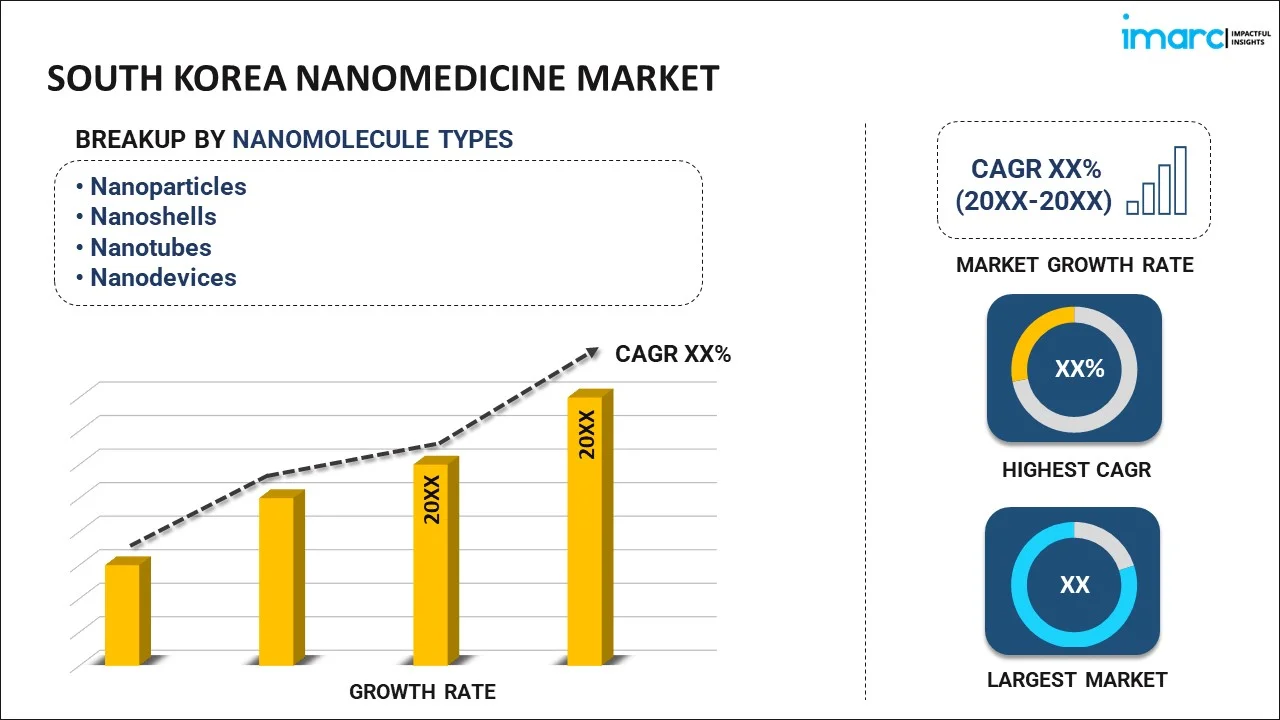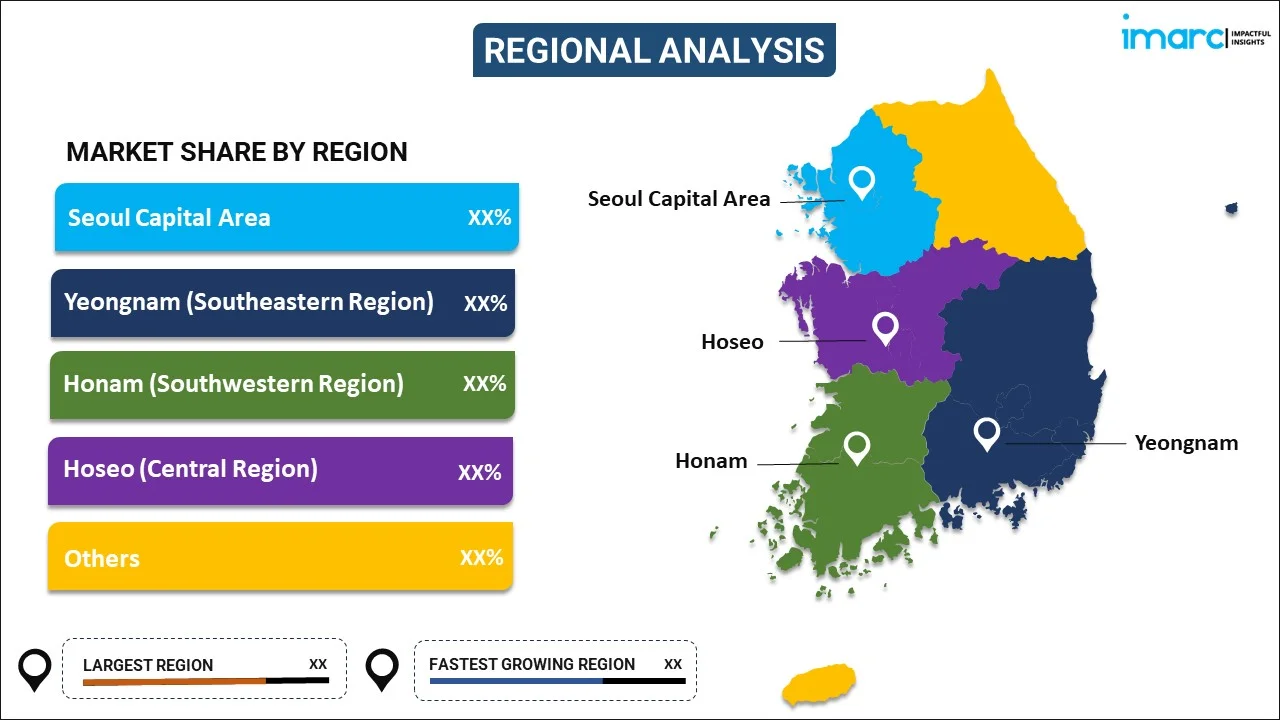
South Korea Nanomedicine Market Report by Nanomolecule Type (Nanoparticles, Nanoshells, Nanotubes, Nanodevices), Product (Therapeutics, Regenerative Medicine, In-Vitro Diagnostics, In-Vivo Diagnostics, Vaccines), Application (Clinical Oncology, Infectious Diseases, Clinical Cardiology, Orthopedics, and Others), and Region 2024-2032
Market Overview:
South Korea nanomedicine market size reached US$ 3.63 Billion in 2023. Looking forward, IMARC Group expects the market to reach US$ 9.18 Billion by 2032, exhibiting a growth rate (CAGR) of 9.60% during 2024-2032. The increasing popularity of nanoparticles that can improve the solubility and bioavailability of poorly water-soluble drugs, thereby leading to better absorption and distribution of drugs within the body is driving the market.
|
Report Attribute
|
Key Statistics
|
|---|---|
|
Base Year
|
2023 |
|
Forecast Years
|
2024-2032 |
|
Historical Years
|
2018-2023
|
| Market Size in 2023 | US$ 3.63 Billion |
| Market Forecast in 2032 | US$ 9.18 Billion |
| Market Growth Rate (2024-2032) | 9.60% |
Nanomedicine is a cutting-edge field that combines the principles of nanotechnology with medical science to revolutionize healthcare on a molecular scale. At this microscopic level, scientists manipulate materials and devices to interact with biological systems, offering unprecedented precision in diagnostics, treatment, and drug delivery. Nanoscale tools, such as nanoparticles and nanorobots, enable targeted therapy at the cellular and molecular levels, minimizing side effects and enhancing therapeutic efficacy. Diagnostic nanoprobes can detect diseases at their earliest stages, facilitating early intervention. Additionally, nanomedicine holds promise for personalized medicine, tailoring treatments to individual patients based on their unique molecular profiles. Despite its immense potential, nanomedicine also raises ethical and safety concerns, necessitating thorough research and regulatory frameworks to ensure responsible development and application in the realm of healthcare.
South Korea Nanomedicine Market Trends:
The nanomedicine market in South Korea is propelled by several key drivers that collectively shape its dynamic market landscape. Firstly, advancements in nanotechnology have provided a robust foundation, enabling the precise manipulation of materials at the nanoscale. This, coupled with breakthroughs in biomedical research, has paved the way for the development of targeted drug delivery systems, a pivotal driver in the nanomedicine market. Moreover, the increasing incidence of chronic diseases, such as cancer and cardiovascular disorders, has intensified the demand for more effective and less invasive therapeutic interventions, fostering the growth of nanomedicine applications. In addition to this, collaborative efforts between academia, industry, and government institutions have played a pivotal role in driving nanomedicine forward. These partnerships facilitate knowledge exchange, funding opportunities, and streamlined regulatory pathways, fostering a conducive environment for R&D. Furthermore, rising investments from pharmaceutical companies keen on harnessing the potential of nanomedicine for drug discovery and development have injected substantial momentum into the market. The convergence of these factors not only propels the nanomedicine market in South Korea but also underscores its transformative potential in revolutionizing healthcare delivery, offering personalized treatments, and addressing unmet medical needs. As research continues to unravel the full spectrum of possibilities, the regional nanomedicine market is poised for sustained growth, promising a paradigm shift in the landscape of healthcare solutions.
South Korea Nanomedicine Market Segmentation:
IMARC Group provides an analysis of the key trends in each segment of the market, along with forecasts at the country levels for 2024-2032. Our report has categorized the market based on nanomolecule type, product, and application.
Nanomolecule Type Insights:

- Nanoparticles
- Metal and Metal Oxide Nanoparticles
- Liposomes
- Polymers and Polymer Drug Conjugates
- Hydrogel Nanoparticles
- Dendrimers
- Inorganic Nanoparticles
- Nanoshells
- Nanotubes
- Nanodevices
The report has provided a detailed breakup and analysis of the market based on the nanomolecule type. This includes nanoparticles (metal and metal oxide nanoparticles, liposomes, polymers and polymer drug conjugates, hydrogel nanoparticles, dendrimers, and inorganic nanoparticles), nanoshells, nanotubes, and nanodevices.
Product Insights:
- Therapeutics
- Regenerative Medicine
- In-Vitro Diagnostics
- In-Vivo Diagnostics
- Vaccines
A detailed breakup and analysis of the market based on the product also been provided in the report. This includes therapeutics, regenerative medicine, in-vitro diagnostics, in-vivo diagnostics, and vaccines.
Application Insights:
- Clinical Oncology
- Infectious Diseases
- Clinical Cardiology
- Orthopedics
- Others
The report has provided a detailed breakup and analysis of the market based on the application. This includes clinical oncology, infectious diseases, clinical cardiology, orthopedics, and others.
Regional Insights:

- Seoul Capital Area
- Yeongnam (Southeastern Region)
- Honam (Southwestern Region)
- Hoseo (Central Region)
- Others
The report has also provided a comprehensive analysis of all the major regional markets, which include Seoul Capital Area, Yeongnam (Southeastern Region), Honam (Southwestern Region), Hoseo (Central Region), and Others.
Competitive Landscape:
The market research report has also provided a comprehensive analysis of the competitive landscape. Competitive analysis such as market structure, key player positioning, top winning strategies, competitive dashboard, and company evaluation quadrant has been covered in the report. Also, detailed profiles of all major companies have been provided.
South Korea Nanomedicine Market Report Coverage:
| Report Features | Details |
|---|---|
| Base Year of the Analysis | 2023 |
| Historical Period | 2018-2023 |
| Forecast Period | 2024-2032 |
| Units | US$ Billion |
| Scope of the Report | Exploration of Historical Trends and Market Outlook, Industry Catalysts and Challenges, Segment-Wise Historical and Future Market Assessment:
|
| Nanomolecule Types Covered |
|
| Products Covered | Therapeutics, Regenerative Medicine, In-Vitro Diagnostics, In-Vivo Diagnostics, Vaccines |
| Applications Covered | Clinical Oncology, Infectious Diseases, Clinical Cardiology, Orthopedics, Others |
| Regions Covered | Seoul Capital Area, Yeongnam (Southeastern Region), Honam (Southwestern Region), Hoseo (Central Region), Others |
| Customization Scope | 10% Free Customization |
| Report Price and Purchase Option | Single User License: US$ 3699 Five User License: US$ 4699 Corporate License: US$ 5699 |
| Post-Sale Analyst Support | 10-12 Weeks |
| Delivery Format | PDF and Excel through Email (We can also provide the editable version of the report in PPT/Word format on special request) |
Key Questions Answered in This Report:
- How has the South Korea nanomedicine market performed so far and how will it perform in the coming years?
- What has been the impact of COVID-19 on the South Korea nanomedicine market?
- What is the breakup of the South Korea nanomedicine market on the basis of nanomolecule type?
- What is the breakup of the South Korea nanomedicine market on the basis of product?
- What is the breakup of the South Korea nanomedicine market on the basis of application?
- What are the various stages in the value chain of the South Korea nanomedicine market?
- What are the key driving factors and challenges in the South Korea nanomedicine?
- What is the structure of the South Korea nanomedicine market and who are the key players?
- What is the degree of competition in the South Korea nanomedicine market?
Key Benefits for Stakeholders:
- IMARC’s industry report offers a comprehensive quantitative analysis of various market segments, historical and current market trends, market forecasts, and dynamics of the South Korea nanomedicine market from 2018-2032.
- The research report provides the latest information on the market drivers, challenges, and opportunities in the South Korea nanomedicine market.
- Porter's five forces analysis assist stakeholders in assessing the impact of new entrants, competitive rivalry, supplier power, buyer power, and the threat of substitution. It helps stakeholders to analyze the level of competition within the South Korea nanomedicine industry and its attractiveness.
- Competitive landscape allows stakeholders to understand their competitive environment and provides an insight into the current positions of key players in the market.
Need more help?
- Speak to our experienced analysts for insights on the current market scenarios.
- Include additional segments and countries to customize the report as per your requirement.
- Gain an unparalleled competitive advantage in your domain by understanding how to utilize the report and positively impacting your operations and revenue.
- For further assistance, please connect with our analysts.
 Inquire Before Buying
Inquire Before Buying
 Speak to an Analyst
Speak to an Analyst
 Request Brochure
Request Brochure
 Request Customization
Request Customization




.webp)




.webp)












